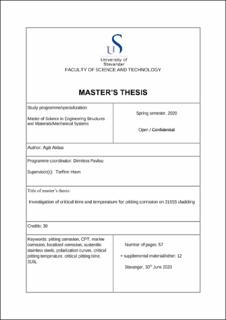| dc.contributor.advisor | Havn, Torfinn | |
| dc.contributor.author | Akbas, Agit | |
| dc.date.accessioned | 2020-09-23T11:31:34Z | |
| dc.date.available | 2020-09-23T11:31:34Z | |
| dc.date.issued | 2020-06-30 | |
| dc.identifier.uri | https://hdl.handle.net/11250/2679252 | |
| dc.description | Master's thesis in Mechanical engineering | en_US |
| dc.description.abstract | The austenitic stainless steel 316L is a very common and low carbon stainless steel grade. 316L has great corrosion characteristics under harsh conditions such as seawater, acidic medias etc. The presence of molybdenum offers greater resistance to corrosion than lower stainless steel grades. Welded steel parts are more susceptible to corrosion due to heat-affected zones, which is why a low carbon content alloy such as 316L is often favored. 316L have been widely used in marine applications for many decades, however localized corrosion attacks such as pitting has been observed in recent years.
This report focuses on limitations and challenges of using 316L in marine applications. The objective of this report is to examine the impact of small differences in molybdenum content, and to investigate critical pitting time and temperature for stainless steel grade 316L in natural seawater. The influence of molybdenum content was studied through several experiments. Anodic cyclic potentiodynamic polarisation curves were obtained according to ASTM G61-86 with 3.56% wt of sodium chloride solution at room temperature. The materials pitting susceptibility factor and pitting resistant equivalent numbers were calculated and compared to results from cyclic potentiodynamic polarization curves. Additionally, open circuit potentials were measured frequently in natural seawater at 4, 8 and 12 degrees through 120 days. The coupons were evaluated by taking pictures before and after, and by using stereo microscopy of the surfaces before and after the experiment.
The results obtained from anodic cyclic potentiodynamic polarization revealed that variations in alloying contents influence the pitting potential where the temperature has a marginally greater effect, although the repassivation potential was not heavily affected. Based on the results obtained from coupon experiments, 2.5% molybdenum content increases the corrosion resistance to an extent. Additionally general corrosion products were observed on several coupons after 120 days of exposure, and there were no significant changes in mass after the experiment. Neither of the samples revealed localized corrosion such as pitting after exposed in natural seawater for 120 days in three different temperatures. | en_US |
| dc.language.iso | eng | en_US |
| dc.publisher | University of Stavanger, Norway | en_US |
| dc.relation.ispartofseries | Masteroppgave/UIS-TN-IMBM/2020; | |
| dc.rights | Navngivelse 4.0 Internasjonal | * |
| dc.rights.uri | http://creativecommons.org/licenses/by/4.0/deed.no | * |
| dc.subject | pitting corrosion | en_US |
| dc.subject | CPT | en_US |
| dc.subject | marine corrosion | en_US |
| dc.subject | pitting 316L | en_US |
| dc.subject | localized corrosion | en_US |
| dc.subject | maskinteknikk | en_US |
| dc.title | Investigation of critical time and temperature for pitting corrosion on 316SS cladding | en_US |
| dc.type | Master thesis | en_US |
| dc.subject.nsi | VDP::Teknologi: 500::Maskinfag: 570 | en_US |
| dc.source.pagenumber | 70 | en_US |

